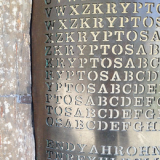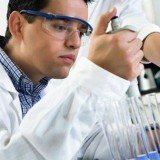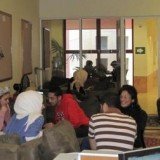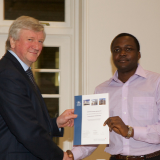A Crack In Creation (2017) Book Summary & Insights
Book Title: A Crack In Creation
Subtitle: The New Power to Control Evolution
Publication Date: 2017
Author Names: Jennifer Doudna and Samuel H. Sternberg
About The Authors
Not since the Atomic bomb has a technology so alarmed its inventors that they warned the world about its use. That is, until 2015, when biologist Jennifer Doudna called for a worldwide moratorium on the use of the new gene-editing tool CRISPR – a revolutionary new technology she helped create – to make heritage changes in human embryos. The cheapest, most effective way of manipulating DNA ever known, CRISPR may well give us the cure to HIV, genetic diseases, and some cancers, and will help address the world’s hunger crisis. Yet even the tiniest changes to DNA could have myriad, unforeseeable consequences – including the ethical and societal repercussions of intentionally mutating embryos to create “better” humans.
Writing with fellow researcher Samuel Sternberg, Doudna shares the thrilling story of her discovery, and passionately argues that enormous responsibility comes with the ability to rewrite the code of life. With CRISPR, she shows, we have taken control of evolution. What will we do with this unfathomable power next?
Book Summary
This book is about the history of gene-editing, the innovation of a gene-editing tool called CRISPR and the ethical and biological implications of its use in human society.
Who Is This Book For?
This book is for everyone ethics, philosophy, science and the fate of humankind which hangs on a balance.
Buy Book: Support The Book Author(s) And Our Work
Great books should be read, studied, and reviewed frequently, so reading the actual book may provide more value to you than the book insights on this page. Besides, this would support the work of the book authors and what we do on LarnEdu. What could be better?
Important Notes
We get a small compensation from Amazon when you visit your nearest/local Amazon site via our affiliate link to purchase an item within 24 hours or if you add it to your cart and checkout within 90 days. This is no additional cost to you and supports our work.
The information on this page is meant to supplement the actual book(it is not a book review but distils the key insights or ideas from the book in under 5000 words). The content creator or LarnEdu does not necessarily support the views, thoughts, and opinions expressed in the text/book. Reasonable skepticism should be applied with any views, thoughts or opinions expressed/shared by the book author or content creator.
Reading the contents of this page does not guarantee specific results. The best lessons are achieved from taking consistent action in the real world rather than being addicted to the illusion of progress by getting stuck on reading an infinite amount of books or book summaries and insights. LarnEdu and the content creator accepts no responsibility or liability for the accuracy of the information on this page or how it is used.
Book Insights

Almost all living organism contain a DNA which is a unique molecule that transmits biological data from generation to the next during reproduction. It involves crucial protocols including cell building, energy creation, and metabolic regulation. Genome is the entire structure of an organism’s DNA. This includes genes which are strings of DNA with particular functions involved in producing proteins which play critical biological functions in the body of an organism. It also includes parts of DNA which speeds up or prevents gene activity, and other parts that have no critical role to protein creation or applicability. Genome editing is the deliberate re-modification of specific DNA sequences to produce expected results. This has assisted in scientific breakthroughs in different areas of medicine and agriculture.
CRISPR technology is an advancement of gene re-modification techniques and you will understand its huge potential for good and evil as I take you through these insights.
Nature Beats Us As The First Gene Editor
Contrary to popular opinion, humans are not the first to attempt gene alteration. For billions of years through eons of time, nature has edited millions of life forms through its process of natural selection. Organism’s that could not thrive in the specific environment nature created died off and the ones who remained passed on genes which made future generations more adaptable. Darwin discovered this in his theory of Evolution where only the fittest survive. We should understand that genetic editing, although mechanical, is not as unnatural as it sounds. There are cases of spontaneous natural editing in nature in this present age like the case of an Ohio woman named Kim with a terrible genetic autoimmune disease who nature cured in her adulthood when one of her chromosomes exploded into pieces and reconfigured itself. Scientists discovered the cure was because of the removal of a harmful gene when the chromosome re-edited itself. Kim suffered from constant bacterial infections as a kid when doctors discovered she had extremely low levels of specific white blood cells needed to combat invading bacteria. Hers was the first known diagnosis of WHIMS (warts, hypogammaglobulinemia, infections, and myelokathexis) syndrome because of a bad CXCR4 gene. This disease is rare with only 60 cases diagnosed worldwide. Diagnosed in the 60s, Kim became free of the disease in 2013, and upon closed scientific scrutiny at her blood cells, they discovered an anomaly; a copy of 2 chromosome was 15% shorter than the other. This revealed nature disrupted her genome sequencing and the bad gene kicked out alongside 163 normal genes.
They attributed this to chromothripis, an event discovered when a chromosome shatters and re-configures itself during cell replication. Sometimes, the rearranged genes may contribute to cancer, this was not the case for Kim. This means there was an involuntary edition of her genome that benefited her health, but what if we could do this on purpose?
Find out in the next insight.
The Impossibility of DNA Design Until Today
Let us begin by understanding what DNA is. It is the basis of all cellular life in humans and almost every other organism. We find DNA in the cell nucleus (where it’s known as nuclear DNA) with a tiny amount found in the mitochondria – also known as mitochondrial DNA or mtDNA. The DNA information in DNA comprises four chemical bases; adenine (A), guanine (G), cytosine (C), and thymine (T). Our DNA contains approximately 3 billion bases and 99% of these are the same in everyone. The configuration of these bases determine the information needed to create and maintain an organism similar to the numerical composition of numbers to solve equations. A fundamental quality of DNA is its ability to make copies of its former self and this is crucial when cells split because the newer cell needs to have the same copy of the DNA present in the old cell.
Now let us focus on gene editing. Scientists searched for methods of editing genes since the 1960s but no progress achieved until 1972 when Herbert Boyer an assistant professor at UCSF laboratory would eventually create a technique for cutting and pasting DNA. They did this by match-making genes to create hybrid DNA sequences called recombinant DNA. This resulted in the genesis of Gene Therapy where cells with healthy genes replaced sick ones. This approach had promise and today gene therapy is being tried out in a few clinics across the US. But gene therapy was not enough. Scientists still needed an accurate way to fight diseases at a molecular level. They needed biological tools that were more precise. They were to discover an artificial protein which could target anomalies at selected locations in a gene. A stable protein able to do this is the zinc-finger nuclease (ZFN). This entered clinical trial in 2017. The drawback is, it is time consuming to adapt a ZFN to combat one out of the thousands of disease-causing genes. It was expensive and time-consuming making it impractical for continuous and widespread medical use.
This went on for almost 10 years until scientists – including the author, discovered CRISPR. Its discovery and subsequent application, has created convenient techniques that are more practicable in real-world situations.
The Evolution Of CRISPR Into A DNA Slicer
Now we know how CRISPR came to be, what exactly is CRISPR and how does it function? First, CRISPR is a short form for “Clusters of regularly interstates short palindromic repeats”. It is a specific region of DNA with two distinct features: nucleotide repeats with spacers. These are the foundations of DNA found in a CRISPR region. We extract spacers from bacteria attacked by past virus. The Spacers remember the attack and can fight future strains of the virus. This was the significant breakthrough for CRISPR and was first seen by food researchers when they used Streptococcus thermophilous, a bacterium in yoghurt and other dairy product. They exposed these bacteria to virus and found that they had integrated new Spacers into the bacteria’s CRISPr region. The “repeats” were like parts of the virus gene. This is how we figured the role of CRISPR in bacteria immunology.
A genome of almost all life forms has within its structure, a mechanism for encoding messages and instructions in their DNA sequences. What CRISPR does is to alter those sequences to change the message. We do this by making a break in the DNA structure and fooling a cell’s repair mechanism into allowing the change we need. The tool responsible for this is Cas9. CAs9 is an RNA guide within CRISPR that moves to any DNA sequence to insert a break. We do this by altering the nucleotide sequence in cRNA which attaches to a similar DNA target. This became simplified by joining cRNA with tracrRNA to create a simple guiding system. This enables gene editing to require only an RNA guide and Cas9 thus making the process simple and easy to use.
The Role of Cas9 In CRISPR Application
In 2012, two published papers changed the function of CRISPr-Cas9 into an easy gene cutting machine. The studies published in Science and PNAS showed that Cas9 can slice any DNA region by altering the nucleotide sequence. We find this nucleotide sequence only in the specific gene and nowhere else so Cas9 would not cut regions excluded. The RNA guide explained in insight three along with Cas9 will slice – like a pair of shears – the DNA at the location only. After cutting, the natural repair mode kick starts the DNA repair protocol. There are two techniques to begin this healing process. The first involves attaching both break points together. We define this as “non-homologous end joining”. The drawback of this method is its susceptibility to errors. We may introduce or remove nucleotide in error which can cause mutations and disrupt a gene. The direct opposite of what we intend. The second is to fill in the break points with intended nucleotides. This is better and more convenient with less chance of error.
It is at this stage gene editing becomes critical. Scientists fill in the break with genetic codes of their choosing thus allowing the DNA to repair itself with an altered gene thus correcting a bad gene.
CRISPR-cas9: Applicability In Science And Medicine
There is no doubting the potential of CRISPR in the application of Medicine and Agriculture. Prior to CRISPR. The technology is convenient to use and is four times effective than the next best gene editing tool – TALEN. Since its inception, there has been noticeable strides in gene technology.
In 2013, there was a report of CRISPR-Cas9 technology to edit human cells in an experiment in the laboratories of the Broad Institute of the Massachusetts Institute of Technology in collaboration with Harvard by Church and Feng Zhang. Research and laboratory experiments have shown improvements in correcting genetic defects in animal adaptations of human diseases. Some of these diseases are Fanconi anaemia and cataracts.
CRISPR technology is also useful in the agricultural industry and has helped to create prebiotic cultures and immunize industrial culture against virus attacks. They have used it to increase yield, tolerance and improve nutritional properties. Another application of this biotechnology is the creation of Gene drives. These are genetic pools which enhance the likelihood of favourable genes passing from parent to future offspring. Over time, the trait becomes widespread through entire species. Gene drive can help control diseases by increasing sterility amongst disease-causing organisms such as mosquitos. But the application of CRISPR technology already raises serious ethical concerns as we see in the next insight.
CRISPR Technology And The Baby Scandal
A Chinese scientist known as He Jiankui made headlines for all the wrong reasons. He is today known as the first scientist to apply CRISPR technology to embryos which has resulted in human birth. The scientist against so many considerations from scientists in the community used Cas9 to delete the CCR5 gene. This gene makes humans vulnerable to HIV infection. His YouTube announcement met widespread condemnation across the world. He Jiankui has left his University and may face criminal charges. Other scientists who may have prior knowledge are being investigated. The Chinese government, may be complicity in the act.
In a quest for fame, He Jankui jumped recklessly into an era we are not prepared for and there are consequences we cannot fully understand today. Just like Icarus, He Jankui may have flown too close to the sun. There is no proof yet the experiment was a success or failure but the experiment has generated a lot of controversy, it may alter the way we conduct gene research for the foreseeable future. There have been calls for a total suspension of gene research until the implications are better understood.
Ethical Considerations And The Way Forward
Some argued the “Baby Scandal” is a good outcome as it speeds up the need for a discussion to find a way forward with the CRISPR technology. There are ethical concerns which we cannot sweep aside and scientists – including government’s across the world, have to sit up and work together. There must be an international legal framework put in place before further biological – and most especially, human experiments with this technology can continue.
The alteration of the human germ line with biotechnology carries with it astronomical consequences. Is this going to be the end of human civilization as we know and the start of a new race of genetically engineered mankind?
Only time will tell.
Key Quotes
Here’re some key quotes from the book:
“The disfunction between scientific consensus and public opinion on the topic of GMOs is disturbing, to say the least.” — Jennifer A. Doudna, A Crack In Creation: Gene Editing and the Unthinkable Power to Control Evolution.
“The power to control our species’ genetic future is awesome and terrifying. Deciding how to handle it may be the biggest challenge we have ever faced.” — Jennifer A. Doudna, A Crack In Creation: Gene Editing and the Unthinkable Power to Control Evolution.
“Have no doubt, this technology will – someday, somewhere – be used to change the genome of our own species in ways that are heritage, forever altering the genetic composition of humankind.” — Jennifer A. Doudna, A Crack In Creation: Gene Editing and the Unthinkable Power to Control Evolution.
Conclusion
Innovative biotechnology like CRISPR has enormous potential to improve our lives. But in the quest to find solutions to our problems, we may end up opening Pandora’s Box and only the future can tell if that will lead to the liberation or annihilation of our species as we know it.
Since You’re Here…
Great books should be read, studied, and reviewed frequently, so reading the actual book may provide more value to you than the book insights on this page. Besides, this would support the work of the book authors and what we do on LarnEdu.
You can also support the work we do at LarnEdu work by making a one/off or monthly donation(via PayPal) for as little as £0.99 or sharing this content.
Do you have any feedback or suggestions? Use the comment section below or send us a message.
Content created by: Tracy















